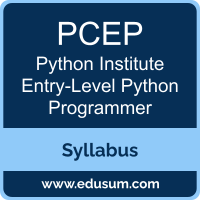 Use this quick start guide to collect all the information about Python Institute Entry-Level Python Programmer (PCEP) Certification exam. This study guide provides a list of objectives and resources that will help you prepare for items on the PCEP Python Institute Certified Entry-Level Python Programmer exam. The Sample Questions will help you identify the type and difficulty level of the questions and the Practice Exams will make you familiar with the format and environment of an exam. You should refer this guide carefully before attempting your actual Python Institute PCEP-30-02 certification exam.
Use this quick start guide to collect all the information about Python Institute Entry-Level Python Programmer (PCEP) Certification exam. This study guide provides a list of objectives and resources that will help you prepare for items on the PCEP Python Institute Certified Entry-Level Python Programmer exam. The Sample Questions will help you identify the type and difficulty level of the questions and the Practice Exams will make you familiar with the format and environment of an exam. You should refer this guide carefully before attempting your actual Python Institute PCEP-30-02 certification exam.
The Python Institute Entry-Level Python Programmer certification is mainly targeted to those candidates who want to build their career in Entry-Level Programmer domain. The Python Institute Certified Entry-Level Python Programmer (PCEP) exam verifies that the candidate possesses the fundamental knowledge and proven skills in the area of Python Institute PCEP-30-02.
Python Institute Entry-Level Python Programmer Exam Summary:
| Exam Name | Python Institute Certified Entry-Level Python Programmer (PCEP) |
| Exam Code | PCEP |
| Exam Price | $69 (USD) |
| Duration | 40 mins |
| Number of Questions | 30 |
| Passing Score | 70% |
| Books / Training |
Python Essentials 1 PCAP Programming Essentials in Python |
| Schedule Exam | OpenEDG Testing Service - TestNow |
| Sample Questions | Python Institute Entry-Level Python Programmer Sample Questions |
| Practice Exam | Python Institute PCEP Certification Practice Exam |
Python Institute PCEP Exam Syllabus Topics:
| Topic | Details |
|---|---|
Computer Programming and Python Fundamentals (18%) |
|
| Understand fundamental terms and definitions |
- interpreting and the interpreter, compilation and the compiler - lexis, syntax, and semantics |
| Understand Python’s logic and structure |
- keywords - instructions - indentation - comments |
| Introduce literals and variables into code and use different numeral systems |
- Boolean, integers, floating-point numbers - scientific notation - strings - binary, octal, decimal, and hexadecimal numeral systems - variables - naming conventions - implementing PEP-8 recommendations |
| Choose operators and data types adequate to the problem |
- numeric operators: ** * / % // + – - string operators: * + - assignment and shortcut operators - unary and binary operators - priorities and binding - bitwise operators: ~ & ^ | << >> - Boolean operators: not, and, or - Boolean expressions - relational operators ( == != > >= < <= ) - the accuracy of floating-point numbers - type casting |
| Perform Input/Output console operations |
- the print() and input() functions - the sep= and end= keyword parameters - the int() and float() functions |
Control Flow – Conditional Blocks and Loops (29%) |
|
| Make decisions and branch the flow with the if instruction |
- conditional statements: if, if-else, if-elif, if-elif-else - multiple conditional statements - nesting conditional statements |
| Perform different types of iterations |
- the pass instruction - building loops with while, for, range(), and in - iterating through sequences - expanding loops with while-else and for-else - nesting loops and conditional statements - controlling loop execution with break and continue |
Data Collections – Tuples, Dictionaries, Lists, and Strings (25%) |
|
| Collect and process data using lists |
- constructing vectors - indexing and slicing - the len() function - list methods: append(), insert(), index(), etc. - functions: len(), sorted() - the del instruction - iterating through lists with the for loop - initializing loops - the in and not in operators - list comprehensions - copying and cloning - lists in lists: matrices and cubes |
| Collect and process data using tuples |
- tuples: indexing, slicing, building, immutability - tuples vs. lists: similarities and differences - lists inside tuples and tuples inside lists |
| Collect and process data using dictionaries |
- dictionaries: building, indexing, adding and removing keys - iterating through dictionaries and their keys and values - checking the existence of keys - methods: keys(), items(), and values() |
| Operate with strings |
- constructing strings - indexing, slicing, immutability - escaping using the \ character - quotes and apostrophes inside strings - multi-line strings - basic string functions and methods |
Functions and Exceptions (28%) |
|
| Decompose the code using functions |
- defining and invoking user-defined functions and generators - the return keyword, returning results - the None keyword - recursion |
| Organize interaction between the function and its environment |
- parameters vs. arguments - positional, keyword, and mixed argument passing - default parameter values - name scopes, name hiding (shadowing), and the global keyword |
| Python Built-In Exceptions Hierarchy |
- BaseException - Exception - SystemExit - KeyboardInterrupt - abstract exceptions - ArithmeticError - LookupError - IndexError - KeyError - TypeError - ValueError |
| Basics of Python Exception Handling |
- try-except / the try-except Exception - ordering the except branches - propagating exceptions through function boundaries - delegating responsibility for handling exceptions |
To ensure success in Python Institute PCEP-30-02 certification exam, we recommend authorized training course, practice test and hands-on experience to prepare for Python Institute Certified Entry-Level Python Programmer (PCEP) exam.
